Abstract
Web 2.0 technologies are promising tools not yet adopted by formal education despite the learning advantages they provide. Also, it remains unclear what effects might arise from gamified web contents. Therefore, we enquire into whether a playful science-learning approach to Web 2.0 as a teaching experience would enhance the interest and abilities of students to perform complex research tasks based on reflection and reasoning. Moreover, fostering challenge and engagement in the learning process of molecular biology issues by using a fantasy-based context is our main goal. We have developed a Web 2.0 model for learning science in upper high school, whose contents and multimedia tasks are displayed in an attractive and casual frame based on elements from movies and video games in order to attract the attention of students. The interest aroused by each section was assessed after tracking the number of page views, comments, and online video views for 18 months. The good reception our gamified tasks have caused among a sample of student supports the basis of interest increase we pursue when contents are displayed in a sort of leisure context. Students are usually prone to work willingly with complex contents as long as the subject matter is presented in a playful online framework where sources and tools are easily available from home. Indeed, students enthusiastically assume an active reasoning and researching active stance when they are challenged to solve tasks in the form of playing-role games based on their own tastes.
Keywords: Playful Learning; GamificationScience EducationWeb 20Upper Secondary SchoolMolecular and Cell Biology
Introduction
In this work, we present a multimedia educational resource for teaching molecular biology in upper high school from a playful point of view. This proposal has been built by means of a website development, using tools and elements from cinema and video games in order to attract fuller attention and interest from students towards these scientific contents. This educative proposal based on gamification includes a package of tasks designed to exploit challenge and engagement as a means of boosting students’ motivation regarding scientific subjects.
Web, Social Networks, and Internet as Teaching Resources
Web services are usually presented as an interface where an application is executed. In the educational field, the term Web 2.0 refers to a reading-and-writing website (McManus, 2005), which overcomes the traditional reading-only approach of Web 1.0 (Cormode & Krishnamurthy, 2008), where students act as mere receptors of knowledge. Web 2.0 fosters the design and implementation of participative and collaborative tasks, thereby duties can be allocated among students and teachers (Lankhear &Knobel, 2006). It is a platform where innovative and educational digital tools can be developed or related (Cormode & Krishnamurthy, 2008): social networks, such as Facebook, platforms for sharing multimedia contents, such as Youtube, websites to develop knowledge in a collaborative way, such as Wikipedia (Valverde-Crespo & González-Sánchez, 2016), or specialized blogs and websites dedicated to encourage art creativity, such as Deviantart. This is a way to interrelate formal academic tasks, such as carrying out works to be reviewed by peers, with some others, which are more informal, provided by Web 2.0 resources, such as online publication of video or audio files focusing on a particular issue (Cohen, 2007). Then, why are not yet Web 2.0 technologies widely adopted in formal education? The answer is mainly because there are not enough models performed by and for teachers. Even though some teachers are already groping the educative options provided by Web 2.0 (Domènech-Casal, 2016), more studies and research are required to prompt a qualitative forward leap from Web 1.o to Web 2.0 (Bull et al. 2008).
Gamification
The use of games should not focus exclusively on the entertainment environment, since the skills players train during the game can be useful to solve problems in real life (McGonial, 2011). The interest of games lies in a mix of fantasy, challenge, and curiosity aroused in players, apart from the possibility for students to get so involved in the process that they reach a high concentration state of mind called “flow” (Kirriemuir& McFarlane, 2004). The aim of gamification (Werbach& Hunter, 2012) is to foster student commitment throughout the teaching process by means of game and competition (Fitz-Walter, Tjondronegoro & Wyeth, 2012). Gamification allows students to receive instantaneous feedback regarding their classroom progress and recognition after they have fulfilled a task (Kapp, 2012). Theoretically, this methodology creates more opportunities for the students to be engaged and motivated when they perform the activities (Simoes, Redondo & Vilas, 2012), though some studies have shown the existence of difficulties achieving this final goal (Gibbs & Poskitt, 2010). Therefore, although recently published works examine educative experiences using a playful strategy (Fernández-Oliveras, Molina & Oliveras, 2016; Galera & Reyes, 2015; Vesga, 2015) further analysis is essential.
Learning through video games
In video games, problems and puzzles increase the degree of difficulty as the player progresses, hence each hurdle becomes a training exercise to reach a higher rank of ability, which is required to face the next challenge. The player challenges himself to improve his skills in order to advance in the game and achieve very particular goals through the information provided in every single moment (McGonial, 2011). The ability to make sense of that information is an essential aim of video games. Some video-game developers have described these effective stratified learning contexts as being based on the exploitation of several interrelated principles, namely: challenge, ability, engagement, and immersion (Bellevue, 2007, 2011). Among these elements, challenge and ability have been proved to be the most important ones to reach the “flow” state of mind when using video games as educational tools (Hamari, 2016). The term refers to a state of high mental concentration where the user focuses on the fulfilment of an engaging activity, as well as the student truly enjoys the experience (Shernoff, Csikszentmihalyi, Schneider, &Shernoff, 2003). According to Csikszentmihalyi (1996), the essential condition to reach such a state is that the individual must employ a high degree of ability to face a meaningful challenge. Nevertheless, the activity should not be too complicated either, so that the odds of success encourage the player to become engaged. In this sense, learning video games should work as a sort of challenge-ability mode, which foments an intellectual growth during the learning process (Fullagar, 2013).
Regarding the rest of elements involved in learning through video games, evidence suggest that the implicit fantasy of simulations and games enhances motivation in a casual way and, therefore, it can boost learning over levels achieved with methods offering no fantasy elements at all (Lepper, &Hodell, 1989).This is partially because games channel the students’ attention to the most relevant features of the learning context (Lepper, & Malone, 1987).
Some studies have concluded that flow experiences strengthen learning, whereas engagement improves it. In other words, flow acts as a positive enhancer for the game performance, but it does not necessarily improve learning skills, whereas the more committed to the task students are, the more they learn (Admiraal, Huizenga, Akkerman& Dam, 2011). Thus, immersion and engagement can be considered to be learning tracers.
Cinema as an educative asset for science
Cinema can be used as a powerful educational tool in schools (Gouyon, 2016), since it allows to build scientific knowledge, social values, and anthropologic skills. Its strength comes from its ability to encourage reflection and analysis through emotional mechanisms (De Puig, 2006), as it has been demonstrated in many teaching experiences (Cottone & Byrd-Bredbenner, 2007; Pérez Parejo, 2010).
Although there are exceptions where cinema media is used to organize stimulating scientific activities for students (Dark, 2005), most research assessing the impact of cinematographic resources on learning adopts a methodology where students play a passive role, just as mere spectators (Zauderer & Ganzer, 2011). It is uncommon to employ the opposite procedure, in such a way that students can apply their knowledge to identify, recognize, and investigate theoretical aspects of a problem and then “build” knowledge from there by themselves (Hyde & Fife, 2005).
Problem Statement
Web 2.0 technologies are promising tools not yet adopted by formal education despite the learning advantages they provide. In addition, it remains unclear what effects might arise from gamified web contents.
Research Questions
Would a playful learning approach of science using Web 2.0 as a teaching experience enhance the interest and abilities of students to perform complex research tasks based on reflection and reasoning?
Purpose of the Study
We hypothesize that the learning process of sciences can be substantially improved through an educative proposal such as the one we present here, which has three main pillars: a Web 2.0 approach; gamification based on students’ hobbies; and the introduction of students to molecular and cell techniques by means of online digital resources to encourage a reflective and reasoning thinking as training for higher education. Thus, the aims of this work are:
General objectives:
To use references and elements from some of the students’ preferred extracurricular interests, such as movies, sports, and video games, as means to work with scientific contents in a relaxed and partially playful environment.
To develop educational multimedia resources to allow students to gain initial familiarity with some of the most common biomedical laboratory procedures and methods, as well as online biocomputing tools, used in molecular biology, so they can acquaint themselves with them long before access to the university.
To encourage teachers in upper high school to design and implement their own websites as educational assets, especially those focused on a Web 2.0 methodology.
Specific objectives:
To develop an interactive website 2.0 in order to facilitate the teaching of biochemistry and molecular biology in upper high school.
To design supporting tasks for the contents displayed on the website making use of challenge, engagement, competition, and collaboration among students from a gamified point of view focused on cinema and video games in order to enhance the learning experience.
To perform an online tracking of our resources to assess whether this approach has successfully aroused interest among users and students from a private academy.
Research Methods
Jedirojo Science website (jedirojo.webs.com) has been developed using the free version of the Webs website builder. This platform was chosen on considering Webs to be a popular free website builder among inexperienced internet users, this reflecting also how easy it can be handled. In addition, its being free of charges is one of its most advantageous features for any teacher or educational institution that is considering putting into practice a similar teaching experience. The teaching resources displayed here have been produced taking Royal Decree 1105/2014, December 26, which establishes the Spanish core curriculum for high and upper high school (Real Decreto 1105/2014, 2014) as a guideline. Contents are currently available in Spanish, except for videos published on the Youtube Jediperseo channel, which are both in English and Spanish. Nonetheless, the English version of the website will soon be ready for users. The scientific elements (texts, pictures, and videos) have been expressly developed for this educational proposal by means of several image-, audio-, and video-editing software such as CorelPhotoHouse, Paint, Power Point, Real One Player, Youtube downloader, Nero Wave Editor, Camtasia Studio, Pinnacle Studio, Photoshop, or Windows Movie Maker among many others. Jedirojo Science also includes some other external features, in which case the original sources have been properly indicated. The soundtracks from popular movies have been used to make published videos more pleasant. However, it does not imply any breach of copyright, on account of none are meant to generate income. In these cases, Youtube and most of copyright owners, do not block videos from being available for the whole community.
In this work, we present two tasks as a sample of the strategy followed in developing our proposal. In particular, these tasks were selected to study the impression they could make on four student of biology in upper high school biology from a private academy (Academia en Casa SL, Granada, Spain). Therefore, their opinions and comments have been taken into account as preliminary data to infer the suitability of the proposal. Moreover, the website traffic and the number of online video views have been tracked for 18 months to assess the level of interest aroused.
Jedirojo Science Proposal
Jedirojo Science is a Web 2.0 (Figure
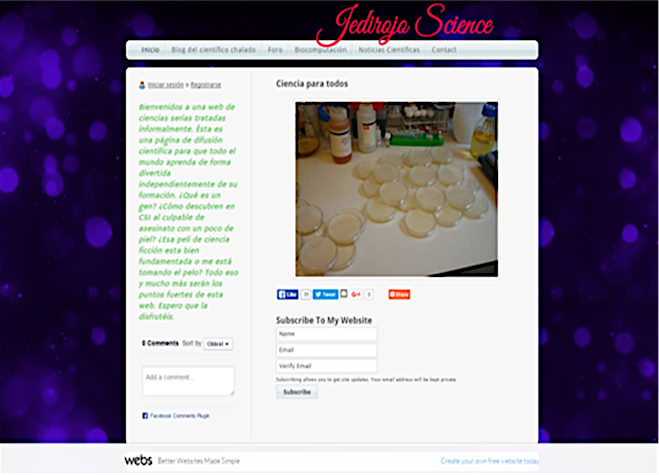
Blog
The most important web resource is
The blog’s entries display upper-high-school curricular contents from subjects such as biology, chemistry, physics, and geology in a humorous style. In particular, cinema, video games, and role-playing games have been selected as the essential elements to teach and learn sciences by means of a playful methodology. All the entries allow users to comment, both questions and suggestions related to the issues addressed. This strategy gives the students a chance to express their own opinions about what they have read, and even better, to propose new subjects according to their concerns
Entries with cinematographic background: Science and Fiction
Science-fiction movies constitute an endless source of ideas and opportunities for science teachers, regardless of their fields of specialization. Therefore, science-fiction movies can be useful to work with different curricular contents and test the knowledge of the students. Under the pretext of disclosing scientific blunders from very popular television series and movies, we intend to deal with contents such as evolution, microbiology, genetic engineering, biotechnology, fossilization or paleontology (Figure
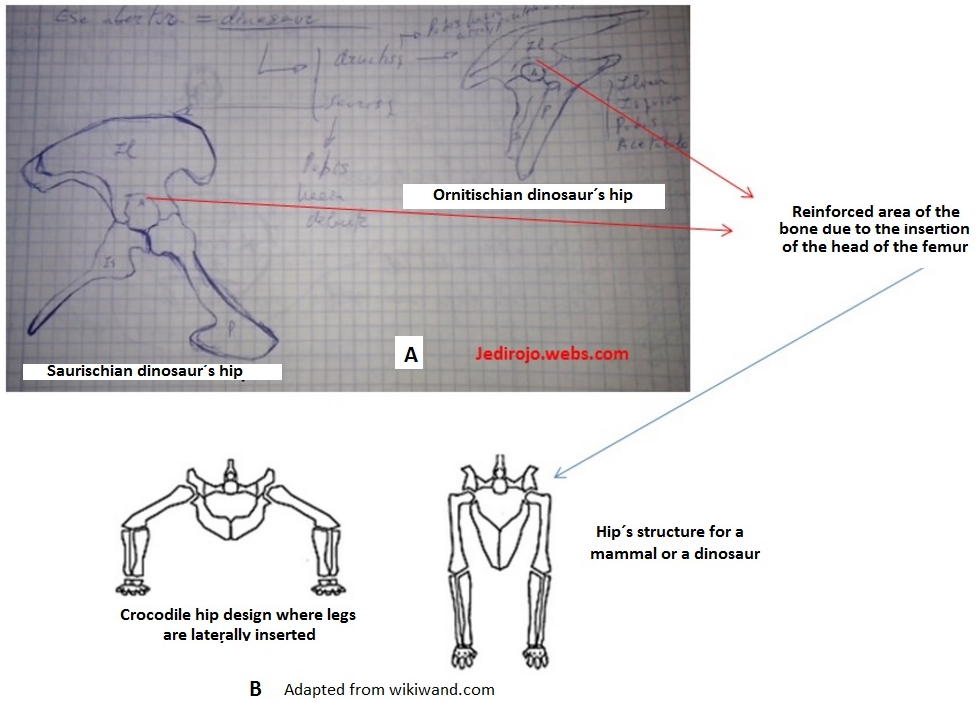
-
Entries about controversial scientific issues: Breaking Myths
Currently, students can find references to extremely important scientific issues for society. This section of the blog tries to enhance their abilities to process information so they can become self-sufficient in contrasting the reliability of that information. Therefore, the subjects displayed here are those whose very nature cause controversy among the general population as well as within the scientific community, as they can be: regenerative medicine, biomedical research, and the ethical conflicts they generate (Figure
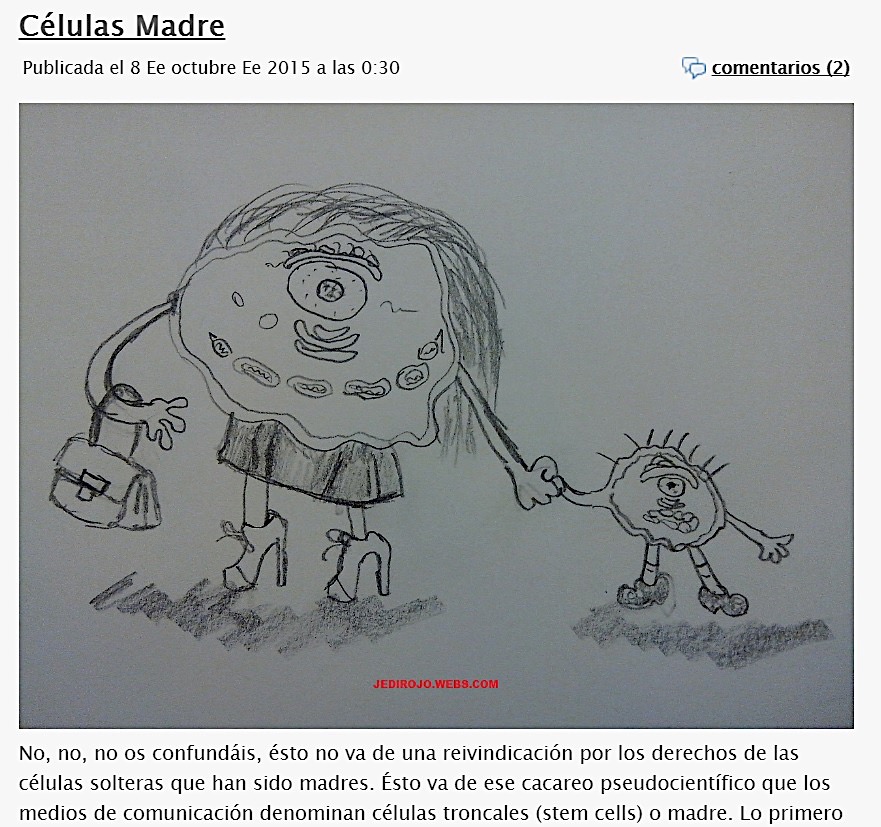
-
Laboratory entries: Lab Assays
In many cases, high-school laboratories are not utilized to perform practical experiences, which implies a serious handicap for students with aspirations to pursue different science degrees at university. This section is meant to reduce the effects of such a situation, at least for biology, biochemistry, and chemistry. The aim is to demonstrate several molecular and cell research techniques and protocols and how to interpret the outcomes (Figure
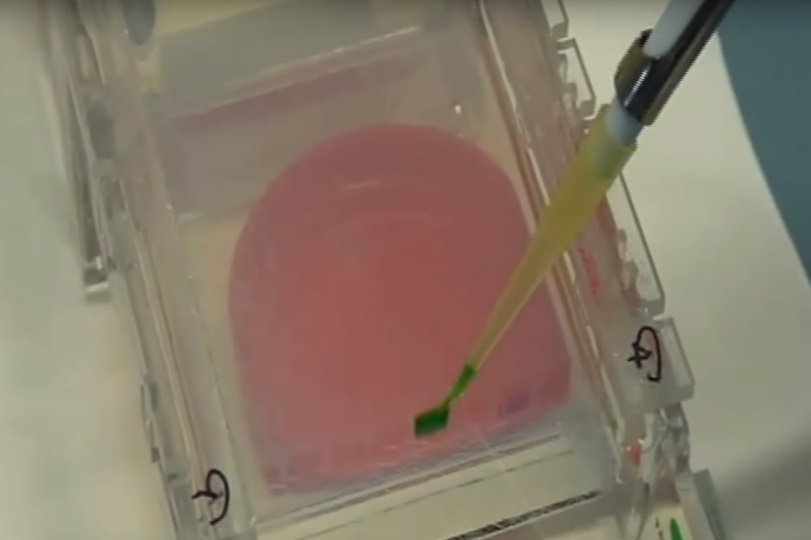
In this particular case, teachers can take advantage of the short documentary film as an illustrative tool. Therefore, blog entries usually have attached links to explanatory videos created for this educational proposal. These videos are found on a Youtube open channel: Jediperseo (https://www.youtube.com/user/Jediperseo). To increase their attraction to students, videos feature soundtracks taken from current popular singers, groups or movies.
The Tasks: Elementary, my dear Watson!
The most interesting components of the web are the tasks presented as a part of a gamified framework based on challenge, ability, immersion, and engagement typical of videogames, and which are important resources for science teaching-learning processes. Videogames, whose industry is steadily growing worldwide, are able to catch the imagination of players for hours while urging them to hone their skills and reach excellence in a virtual world. Thus, if it were possible to achieve such an attitude within an academic environment, students would develop impressive abilities and merely for the sheer pleasure of passing a challenge as they still enjoy the experience. The package of tasks located on the web tries to follow the path taken in the 1990s by the so-called graphic-adventure games such as Monkey Island, Maniac Mansion or Indiana Jones and the Fate of Atlantis (Lucasart), where players played the role of the main character and had to interact with the environment and other characters in order to solve problems, puzzles or riddles by sharpening their wits. Teachers could try to exploit those features of video games so attractive to teenagers (and adults) and prepare motivating activities for students, intended to stimulate eagerness for learning. The aforementioned graphic-adventure games are, in a sense, the next step in the history of role-playing games and game books whose motto was “choose your own adventure” (like the ones released in Spain by Timun Mas publishing house), and where the reader played the leading role in countless adventure or mystery stories so that he or she could solve a crime or situation by applying intelligence.
This strategy draws more and more users by strengthening the approach of challenge by providing first-person scenes, which help players immerse themselves in the virtual world, as in the case for The X-Files: The Game (PlayStation, 1998), Heavy Rain and L.A. Noire (PlayStation3, 2010 and 2011, respectively), and Beyond: Two Souls or The Last Of Us (PlayStation4 and X-Box360, 2013 both). Graphic adventure in first person based on solving crimes currently enjoys incomparable prestige, thanks to complex scripts, compelling challenges, “official” documents available to be handled in order to bestow higher realism, and the need to acquire scientific knowledge from the forensic field to go forward. All of these constitute a distinguishing mark of the present generation of entertaining digital services, which in fact are determining current students’ tastes.
The last of the inspiring elements of these online tasks is television, which often promotes vocations such as medicine or the legal profession. It is especially meaningful that a growing number of people wish to dedicate their lives to laboratory research or practise forensic medicine. It is likely to be related to the volley of medical and police series on TV: starting with CSI and all the subsequent versions; following the odd House; and ending with the later adaptations of Poirot and Holmes: Castle, Bones, the Mentalist, etc.
From this web section, we have selected the two most significant tasks to be presented:
The Warren File and the Price of Secrets
This task is presented like an online video (https://goo.gl/lk6Jix). It tells the story of Dana Warren’s murder, and students must play the role of a rooky coroner to solve the crime. It clearly should be attempted only after students have read the proper entries of the blog and/or answered their doubts online on their own, but in all cases under a teacher’s supervision. Then, the challenge consists in deducing who of the five suspects committed the crime, why, and how. This can be achieved only after correctly interpreting the outcomes from a PCR assay and the rest of evidence (Figure
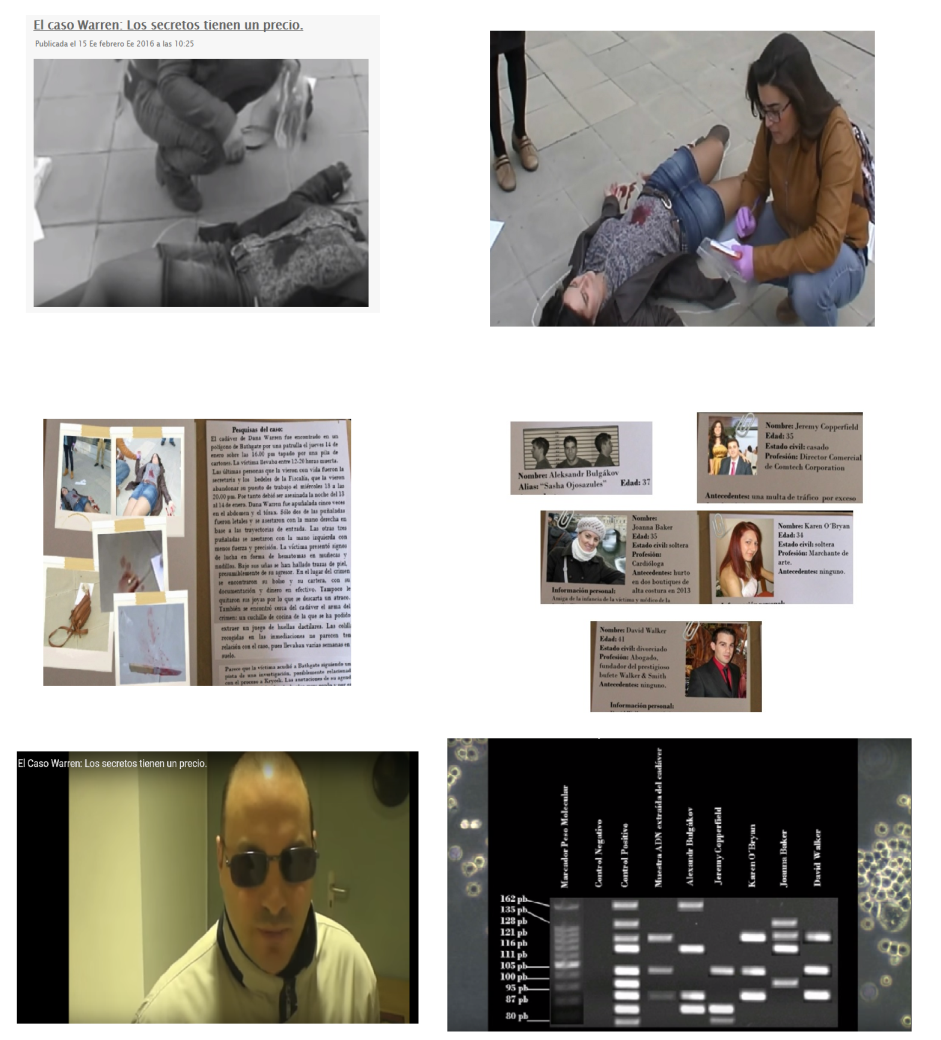
-
The drug against sickle-cellanaemia
This activity (Figure
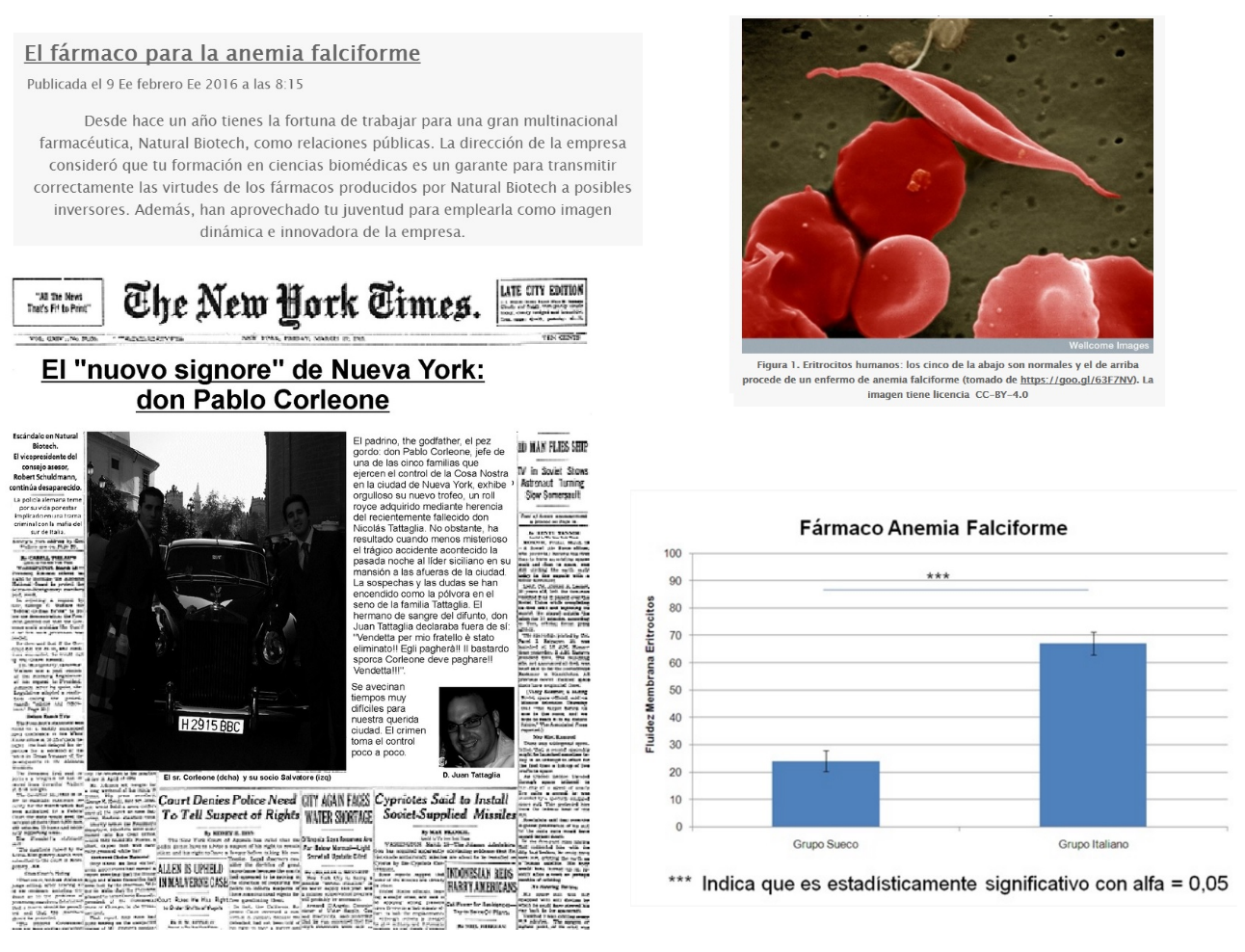
Findings
The platform builder Webs reports the number of page views, comments, and forms the website has received, thus making it easier to track which entries have aroused more interest. Jedirojo Science currently counts on 20 users and subscribers. Since the day it was created in October 2015 it has had more than 3000 page views (Figure
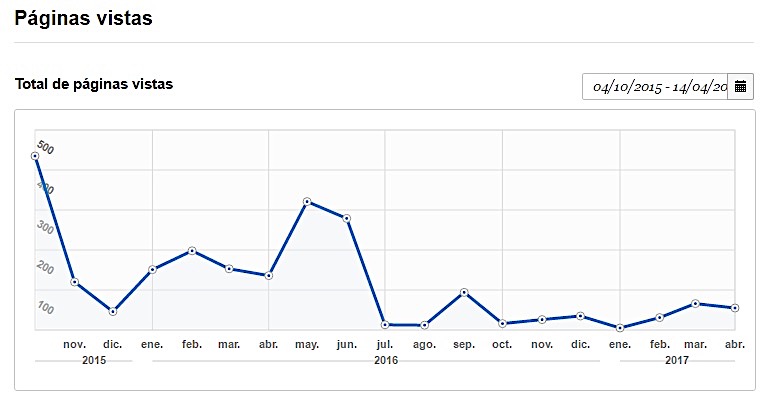
Regarding
Views on Youtube have reached more than 10000 (Figure
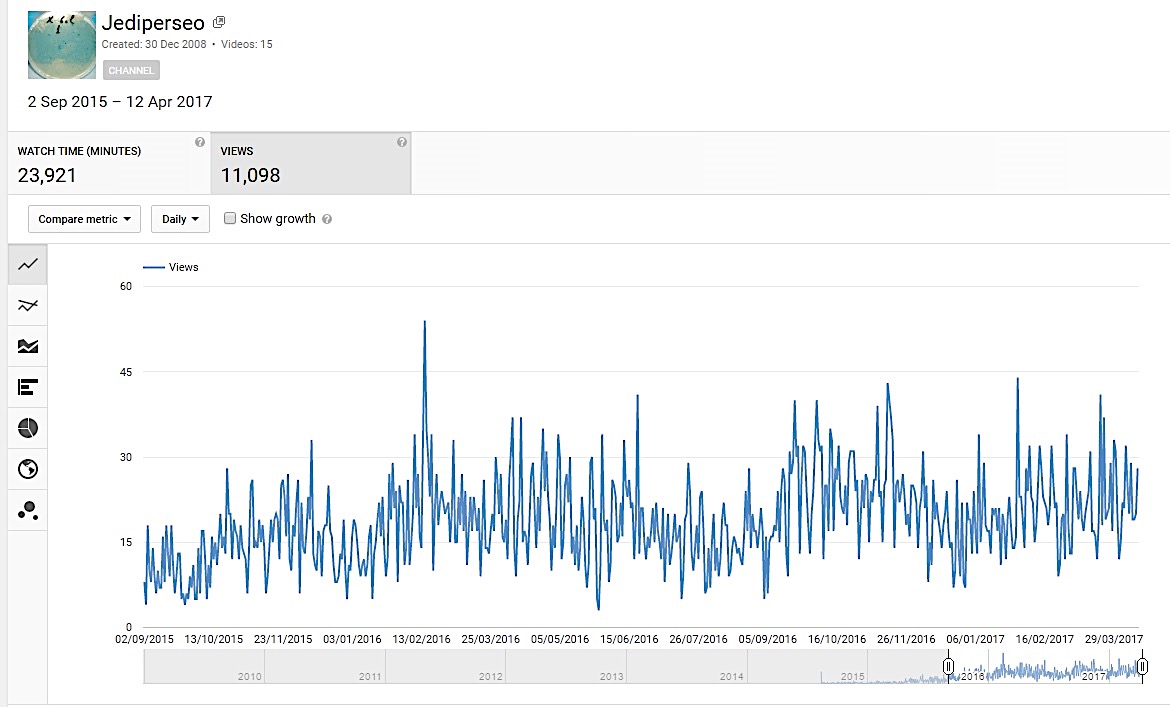
The entries stirring the strongest interest have been the ones from Science and Fiction (especially those focusing on analysing science-fiction movies), which supports the hypothesis implying that science presented as a part of cinematographic leisure connects better to general public and improves its educational potential. Whereas the web section for tasks is the one receiving less views, we should instead consider that upper high school students from the private academy Academia en Casa SL have been a minor percentage of the whole of this website users. In spite of this, as mentioned above, the tasks shown in this work were used with these students.
Both tasks were well received by the students. The Warren File task was performed by two students, though only one of them posted her conclusions in the forum, whereas the other one handed in his work on paper. The former was able to deduce who the murderer really was, proving she properly understood the molecular basis of PCR assays and knew how to apply related curricular contents of biology seen in class and on the web. On the other hand, the second student did not take enough time to think through the problem, and his answers were hasty. The likely lack of reflection translated as an incorrect deduction of the murderer, and in fact he concluded that there had been two killers at once, contradicting the evidence. This may suggest that the latter student was less engaged than the former one, who was really excited by the task. In any case, both of them gave brief answers, failing to fulfil the serious report they were asked to make.
Two other students completed the task about the sickle-cell anaemia. Both liked the idea and showed interest and firm commitment to solve the challenge, but neither could reach a completely satisfactory explanation, although for different reasons. The first did a thorough search of verified references, accomplishing one of the aims of this proposal, i.e. to look for updated background data in formal scientific journals and books instead of taking the first thing the browser offers. However, she was unable to make sense of it and relate the nature of the disease, the composition of lipid membranes, and the effect of diet on them. The second student was indeed able to see the importance of the relationship between the disease and the composition of membranes, and thus she deduced that the drug was rejected because of a poor experimental design, but her insufficient search for background information prevented her for realizing that the diet was the determining factor to solve this challenge.
Conclusion
The educational proposal for teaching biology from a gamified approach using the Web 2.0 Jedirojo Science and Jediperseo Youtube channel is quite promising. Considering comments and questions made by users, we conclude that the development of a website for a teaching-learning process of science seems to be a positive agent for enhancing interest and connectivity among students.
Implications
The assessment of tasks were preliminary and qualitative, based on the work developed by the upper high school students from the private academy Academia en Casa SL mentioned above. Not only the final answers but also the engagement, reflection, interest and commitment to solve the challenges were considered in the assessment criteria of the tasks.
Engagement is clearly an essential factor to achieve educational goals, but it is also true that its effects can be boosted when curricular contents are presented in a playful framework based on cinema, so that, for instance, students can immerse themselves in a fantasy where they are challenged to solve tasks, as the outcomes of the pilot study suggest.
However, it must be considered why reasonably talented students for academic competencies have solved only some, but not all, of the aspects of the tasks. Perhaps these tasks are too complex for a single student, and consequently we deem it would be more effective for students if they were arranged in heterogeneous groups. In that case, the abilities of members might overlap, covering then the deficiencies of the rest. This approach would also encourage the cooperation of members and might be used as training for working as a
In any case, this educational proposal must be considered a dynamic resource for teaching, which will need to be modified over the course of time in order to improve the experience. Therefore, it would be recommendable to incorporate entries and activities suggested and/or prepared by students, so the interactive element of the web will be widened, and consequently its Web 2.0 nature. Moreover, the assessment of tasks should be completed by designing and applying specific assessment tools, as rubrics, in order to determine achievement levels based on a combination of both qualitative and quantitative components.
Acknowledgments
Grateful thanks to the Secretariado de InnovaciónDocente (University of Granada, Spain), for financing Teaching Innovation Project l5-44.
References
- Admiraal W., Huizenga J., Akkerman S., Dam G.T. (2011). The concept of flow in collaborative game-based learning. Computers in Human Behavior 27(3), 1185-1194.
- Bull G., Thompson A., Searson M., Garofalo J., Park J., Young C., Lee J. (2008). Connecting informal and formal learning: Experiences in the age of participatory media. Contemporary Issues inTechnology and Teacher Education 8(2). http://www.citejournal.org/vol8/iss2/editorial/article1.cfm
- Bellevue W. (2007). Portal (Videojuego): Valve Corporation.
- Bellevue W. (2011). Portal 2 (Videojuego): Valve Corporation.
- Cormode G., Krishnamurthy B. (2008). Key differences between Web 1.0 and Web 2.0. First Monday 13(6). http://firstmonday.org/article/view/2125/1972
- Cottone E., Byrd-Bredbenner C. (2007). Knowledge and psychosocial effects of the film supersize me on young adults. Journal of the American Diet Association 107(7), 1197-1203. doi:
- Csikszentmihalyi M. (1996). Creativity: Flow and the psychology of discovery and invention. New York: Harper Collins.
- Dark M.L., (2005). Using science fiction movies in introductory physics. The Physics Teacher 43, 463; doi: 10.1119/1.2060648. DOI: 10.1119/1.2060648
- De Puig I. (2006). Cinema per pensar, Grup d’'InnovacióiRecer per al'Ensenyament la Filos. Butlletí de filosofia 1-24.
- Domènech-Casal J. (2016). Gene Hunting: unasecuenciacontextualizada de indagaciónalrededor de la expresióngénica, la investigación in silico y la ética en la comunicaciónbiomédica. Revista Eureka sobreEnseñanza y Divulgación de lasCiencias 13(2), 342-358. http://reuredc.uca.es/index.php/tavira/article/viewFile/824/881
- Fernández-Oliveras A., Molina V., Oliveras M.L. (2015).Estudio de unapropuestalúdica para la educacióncientífica y matemáticaglobalizada en infantil. Revista Eureka sobreEnseñanza y Divulgación de lasCiencias 13(2), 373-383. http://reuredc.uca.es/index.php/tavira/article/view/910
- Fitz-Walter Z., Tjondronegoro D., Wyeth P. (2012). A gamified mobile application for engaging new students at university orientation. In Proceedings of the 24th Australian Computer-Human Interaction Conference, ACM 138-141.
- Fullagar C., Knight P.A.., Sovern H.S. (2013). Challenge/skill balance, flow, and performance anxiety: An International Review. Applied Psychology 62(2), 236-259.
- Galera M., Reyes J. (2015).Influencia de Concept Cartoons en la motivación y resultadosacadémicos de los estudiantes. Revista Eureka sobreEnseñanza y Divulgación de lasCiencias 12(3), 419-440. http://hdl.handle.net/10498/17600
- Gibbs R., Poskitt, J. M. (2010). Student engagement in the middle years of schooling (years 7-10): A literature review. Wellington, New Zealand: Ministry of Education
- Gouyon J.B. (2016). Science and film-making. Public Understanding of Science 25(1), 17–30.
- Hamari J. (2016). Challenging games help students learn: An empirical study on engagement, flow and immersion in game-based learning. Computers in Human Behavior 54, 170–179.
- Hyde N.B., Fife, E. (2005). Innovative instructional strategy using cinema films in an undergraduate nursing course. ABNF Journal 16(5), 95-97.
- Kapp K.M. (2012).The gamification of learning and instruction: Game-based methods and strategies for training and education. John Wiley & Sons.
- Kirriemuir J., McFarlane A. (2004).Literature review in games and learning. A NESTA Futurelab Research report - report 8. https://telearn.archives-ouvertes.fr/hal-00190453/document
- Lankshear C., Knobel M. (2006).New literacies: Everyday practices and classroom learning (2nd ed.). Maidenhead, UK: Open University Press.
- Lepper M., Hodell M. (1989). Intrinsic motivation in the classroom. San Diego, CA: Academic Press. C. Ames, R. Ames ed. Research in motivation in education, 3, 73-105.
- Lepper M., Malone, T.W. (1987). Intrinsic motivation and instructional effectiveness in computer-based education. Hilldale, NJ: Erlbaum. R. E. Snow, M. J. Farr (Eds.) Conative and affective process analysis: Aptitudes, learning, and instruction. Vol. 3, 255-286.
- McGonigal J. (2011). Reality is broken: Why games make us better and how they can change the world. New York: Penguin Press.
- McManus R. (2005). Web 2.0 is not about version numbers or betas. Read/Write Web. http://readwrite.com/2005/08/06/web_20_is_not_a/
- Pérez Parejo R. (2010). Cine y educación: explotacióndidáctica y algunasexperienciaseducativas. Paper presented at the II CongrésInternacional de Didàctiques. Universidad de Gerona, Gerona.
- Shernoff D., Csikszentmihalyi M., Schneider B., Shernoff, E.S. (2003). Student engagement in high school classrooms from the perspective of flow theory. School Psychology Quarterly 18(2), 158-176.
- Simoes J., Redondo R., Vilas A. (2012). A social gamification framework for a K-6 learning platform. Computers in Human Behavior 29(2013), 345-353.
- Valverde-Crespo D., González-Sánchez J. (2016). Búsqueda y selección de información en recursosdigitales: Percepciones de alumnos de Física y Química de EducaciónSecundariaObligatoria y Bachilleratosobre Wikipedia. Revista Eureka sobreEnseñanza y Divulgación de lasCiencias 13(1), 67-83. http://reuredc.uca.es/index.php/tavira/article/view/857
- Vesga A. (2015). La cienciaficcióncomoherramientapedagógica en un curso de Estudios en Ciencia, Tecnología y Sociedad: descripción de unaexperienciadocente. Revista Eureka sobreEnseñanza y Divulgación de lasCiencias 12(3), 520-528. http://hdl.handle.net/10498/17606
- Werbach K., Hunter D. (2012). For the win: How game thinking can revolutionize your business. Wharton Digital Press. ISBN 1613630239
- Zauderer C.R., Ganzer C. A. (2011). Cinematic technology: the role of visual learning. Nurse Education 36(2), 76-79. doi:
Copyright information

This work is licensed under a Creative Commons Attribution-NonCommercial-NoDerivatives 4.0 International License.
About this article
Publication Date
29 November 2017
Article Doi
eBook ISBN
978-1-80296-031-0
Publisher
Future Academy
Volume
32
Print ISBN (optional)
-
Edition Number
1st Edition
Pages
1-200
Subjects
Sociolinguistics, linguistics, family psychology, child psychology, developmental psychology
Cite this article as:
Fernández-Rubio, P., & Fernández-Oliveras, A. (2017). A Web 2.0 For The Gamification Of Sciences In High School: Jedirojo Science. In Z. Bekirogullari, M. Y. Minas, & R. X. Thambusamy (Eds.), Cognitive - Social, and Behavioural Sciences - icCSBs 2017, October, vol 32. European Proceedings of Social and Behavioural Sciences (pp. 186-200). Future Academy. https://doi.org/10.15405/epsbs.2017.11.18

